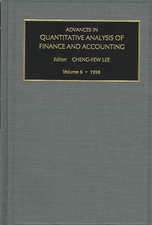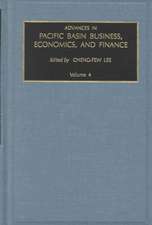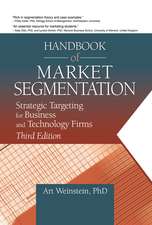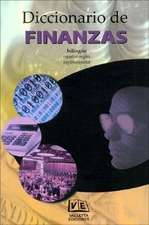Handbook of Quantitative Finance and Risk Management
Editat de Cheng-Few Lee, John Leeen Limba Engleză Hardback – 11 iun 2010
Preț: 5080.79 lei
Preț vechi: 6685.26 lei
-24% Nou
Puncte Express: 7621
Preț estimativ în valută:
972.34€ • 1011.38$ • 802.72£
972.34€ • 1011.38$ • 802.72£
Carte tipărită la comandă
Livrare economică 10-16 aprilie
Preluare comenzi: 021 569.72.76
Specificații
ISBN-13: 9780387771168
ISBN-10: 0387771166
Pagini: 352
Ilustrații: CXIV, 1716 p. In 3 volumes, not available separately.
Dimensiuni: 210 x 279 x 185 mm
Greutate: 4.9 kg
Ediția:2010
Editura: Springer Us
Colecția Springer
Locul publicării:New York, NY, United States
ISBN-10: 0387771166
Pagini: 352
Ilustrații: CXIV, 1716 p. In 3 volumes, not available separately.
Dimensiuni: 210 x 279 x 185 mm
Greutate: 4.9 kg
Ediția:2010
Editura: Springer Us
Colecția Springer
Locul publicării:New York, NY, United States
Public țintă
ResearchCuprins
Overview of Quantitative Finance and Risk Management Research.- Portfolio Theory and Investment Analysis.- Options and Option Pricing Theory.- Risk Management.- Theory, Methodology, and Applications.
Notă biografică
Cheng-Few Lee is a Distinguished Professor of Finance at Rutgers Business School, Rutgers University and was chairperson of the Department of Finance from 1988–1995. He has also served on the faculty of the University of Illinois (IBE Professor of Finance) and the University of Georgia. He has maintained academic and consulting ties in Taiwan, Hong Kong, China and the United States for the past three decades. He has been a consultant to many prominent groups including, the American Insurance Group, the World Bank, the United Nations, The Marmon Group Inc., Wintek Corporation and Polaris Financial Group, etc. Professor Lee has been ranked the most published finance professor worldwide during 1953–2008.
Alice C. Lee is currently a Vice President in the Model Validation Group, Enterprise Risk Management, at State Street Corporation. Most recently, she was an Assistant Professor of Finance at San Francisco State University. She has over 20 years of experience and a diverse background, which includes academia, engineering, sales, and management consulting. Her primary areas of teaching and research are corporate finance and financial institutions. She is coauthor of Statistics for Business and Financial Economics, 2e (with Cheng F. Lee and John C. Lee) and Financial Analysis, Planning and Forecasting, 2e (with Cheng F. Lee and John C. Lee). In addition, she has co-edited other annual publications including Advances in Investment Analysis and Portfolio Management (with Cheng F. Lee).
John C. Lee is a Microsoft Certified Professional in Microsoft Visual Basic and Microsoft Excel VBA. He has a Bachelor and Masters degree in accounting from the University of Illinois at Urbana-Champaign. John has worked over 20 years in both the business and technical fields as an accountant, auditor, systems analyst and as a business software developer. He is the author of the book on how to use MINITAB and Microsoft Excel to do statistical analysis which is acompanion text to Statistics of Business and Financial Economics, of which he is one of the co-authors. John has been a Senior Technology Officer at the Chase Manhattan Bank and Assistant Vice President at Merrill Lynch. Currently, he is the Director of the Center for PBBEF Research.
Alice C. Lee is currently a Vice President in the Model Validation Group, Enterprise Risk Management, at State Street Corporation. Most recently, she was an Assistant Professor of Finance at San Francisco State University. She has over 20 years of experience and a diverse background, which includes academia, engineering, sales, and management consulting. Her primary areas of teaching and research are corporate finance and financial institutions. She is coauthor of Statistics for Business and Financial Economics, 2e (with Cheng F. Lee and John C. Lee) and Financial Analysis, Planning and Forecasting, 2e (with Cheng F. Lee and John C. Lee). In addition, she has co-edited other annual publications including Advances in Investment Analysis and Portfolio Management (with Cheng F. Lee).
John C. Lee is a Microsoft Certified Professional in Microsoft Visual Basic and Microsoft Excel VBA. He has a Bachelor and Masters degree in accounting from the University of Illinois at Urbana-Champaign. John has worked over 20 years in both the business and technical fields as an accountant, auditor, systems analyst and as a business software developer. He is the author of the book on how to use MINITAB and Microsoft Excel to do statistical analysis which is acompanion text to Statistics of Business and Financial Economics, of which he is one of the co-authors. John has been a Senior Technology Officer at the Chase Manhattan Bank and Assistant Vice President at Merrill Lynch. Currently, he is the Director of the Center for PBBEF Research.
Textul de pe ultima copertă
Quantitative finance is a combination of economics, accounting, statistics, econometrics, mathematics, stochastic process, and computer science and technology. Increasingly, the tools of financial analysis are being applied to assess, monitor, and mitigate risk, especially in the context of globalization, market volatility, and economic crisis. This three-volume handbook, comprised of over 100 chapters, is the most comprehensive resource in the field to date, integrating the most current theory, methodology, policy, and practical applications. Showcasing contributions from an international array of experts, the Handbook of Quantitative Finance and Risk Management is unparalleled in the breadth and depth of its coverage. Volume 1 presents an overview of quantitative finance and risk management research, covering the essential theories, policies, and empirical methodologies used in the field. Chapters provide in-depth discussion of portfolio theory and investment analysis. Volume 2 covers options and option pricing theory and risk management. Volume 3 presents a wide variety of models and analytical tools. Throughout, the handbook offers illustrative case examples, worked equations, and extensive references; additional features include chapter abstracts, keywords, and author and subject indices. From "arbitrage" to "yield spreads," the Handbook of Quantitative Finance and Risk Management will serve as an essential resource for academics, educators, students, policymakers, and practitioners.
Selected entries include:
Selected entries include:
- Michael J. Brennan and Yihong Xia on "Persistence, Predictability and Portfolio Planning"
- Kenton K. Yee on "Combining Fundamental Measures for Stock Selection"
- Itzhak Venezia on "Asian Options"
- Ren-Raw Chen, Ben Logan, Oded Palmon, and Larry Shepp on "Dividends vs. Reinvestments in ContinuousTime"
- Fathali Firoozi and Donald Lien on "Capital Structure and Entre Deterrence"
- Lan-Chih Ho, John Cadle, and Michael Theobald on "Portfolio Insurance Strategies – Review of Theory and Empirical Studies"
- Gurdip Bakshi, Charles Cao, and Zhiwu Chen on "Option Pricing and Hedging Performance under Stochastic Volatility and Stochastic Interest Rates"
- C.H. Ted Hong on "Dynamic Econometric Loss Model: A Default Study of US Subprime Market"
- N.K. Chidambaran on "Genetic Programming for Option Pricing"
Caracteristici
Most comprehensive resource on the topic of quantitative finance and risk management to date—including theories, models and tools, and practical applications Features a variety of elements, including definitional terms and descriptive entries, thematic essays from authoritative contributors, and empirical methodologies Global in coverage, integrates concepts from the fields of economics, accounting, statistics, mathematics, and computer science Lead editor, C.F. Lee, is one of the most prolific and well-known authors in the field Includes supplementary material: sn.pub/extras



























